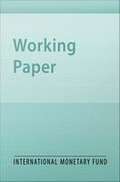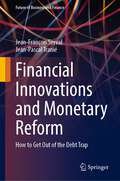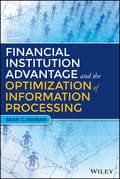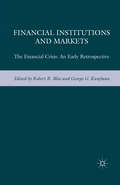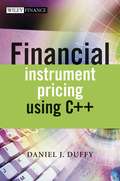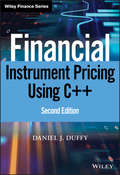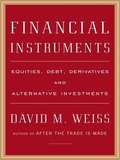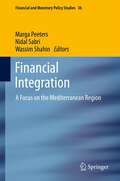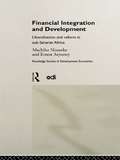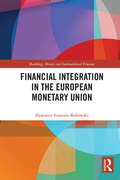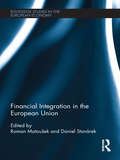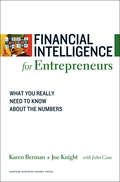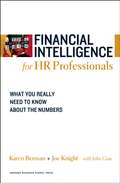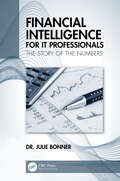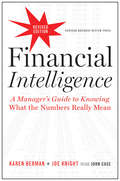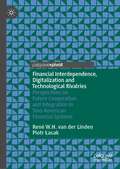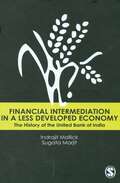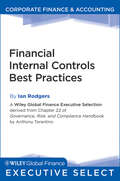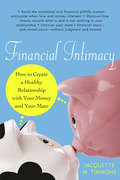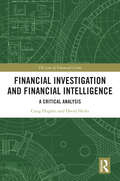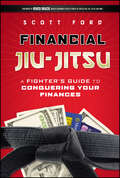- Table View
- List View
Financial Innovation, the Discovery of Risk, and the U.S. Credit Crisis
by Enrique G. Mendoza Emine BozA report from the International Monetary Fund.
Financial Innovations and Monetary Reform: How to Get Out of the Debt Trap (Future of Business and Finance)
by Jean-Pascal Tranié Jean-François ServalWritten by two leading experts on multinational accounting and billion-dollar international investment funds, this book provides a framework for a global reform of the world monetary system, and defines a decidedly new approach to dealing with public debt mortgage, an issue that we can see in many countries in Europe and around the world. The authors put forward a proposal for transforming sterile financial masses, which are withdrawn from the real economy as they no longer bear interest, into wealth. To facilitate this return to the real economy, the authors propose that a significant share of public debt be converted into net equities in the world of business and goods production in order to find new profitable investment projects. The idea is bold, and the authors strive to demonstrate its technical feasibility. They are convinced that this approach can accompany and enhance a movement that has already begun, namely the implementation of vast national and international investment programs in major infrastructures and research projects in innovative sectors. This work builds on the authors’ two previous books, which focus on the monetary system. The first, published in 2010 and including a foreword by former French Finance Minister Christine Lagarde, analyzes the new virtual dimension of money. The second, published in 2014, puts forward an innovative proposal for a new financial regulation aimed at more stable economies. This third book is intended for professionals in the financial industry, including decision makers at banks, accounting and private equity firms, as well as policymakers at central banks and government institutions involved in the implementation of financial and monetary reforms.
Financial Institution Advantage & the Optimization of Information Processing
by Sean C. KeenanThis book will: Discuss unique approaches to meet regulatory requirements and provide resources to these activitiesExplain the link between data governance and model governance and provide an integrated approach to save millions of investment and improve the overall risk/return profile of the firmProvide guiding principles to how to approach and resource model risk and data risk managementAssist System designers within financial institutions to connect and understand the core data architecture level, specific application requirements and performance related to data storage and retrievalExplain why/how huge model and data related gaffs have severely damaged the reputation of several high-profile financial institutions and could have been avoided
Financial Institutions and Markets: The Financial Crisis: An Early Retrospective (Innovations In Financial Markets And Institutions Ser. #6)
by George G. Kaufman Robert R. BlissThis book is a collection of research papers that contribute to the understanding of ongoing developments in financial institutions and markets both in the United States and globally.
Financial Instrument Pricing Using C++
by Daniel J. DuffyOne of the best languages for the development of financial engineering and instrument pricing applications is C++. This book has several features that allow developers to write robust, flexible and extensible software systems. The book is an ANSI/ISO standard, fully object-oriented and interfaces with many third-party applications. It has support for templates and generic programming, massive reusability using templates (?write once?) and support for legacy C applications.In this book, author Daniel J. Duffy brings C++ to the next level by applying it to the design and implementation of classes, libraries and applications for option and derivative pricing models. He employs modern software engineering techniques to produce industrial-strength applications: Using the Standard Template Library (STL) in financeCreating your own template classes and functionsReusable data structures for vectors, matrices and tensorsClasses for numerical analysis (numerical linear algebra ?)Solving the Black Scholes equations, exact and approximate solutionsImplementing the Finite Difference Method in C++Integration with the ?Gang of Four? Design PatternsInterfacing with Excel (output and Add-Ins)Financial engineering and XMLCash flow and yield curvesIncluded with the book is a CD containing the source code in the Datasim Financial Toolkit. You can use this to get up to speed with your C++ applications by reusing existing classes and libraries.'Unique... Let's all give a warm welcome to modern pricing tools.' -- Paul Wilmott, mathematician, author and fund manager
Financial Instrument Pricing Using C++ (Wiley Finance)
by Daniel J. DuffyAn integrated guide to C++ and computational finance This complete guide to C++ and computational finance is a follow-up and major extension to Daniel J. Duffy's 2004 edition of Financial Instrument Pricing Using C++. Both C++ and computational finance have evolved and changed dramatically in the last ten years and this book documents these improvements. Duffy focuses on these developments and the advantages for the quant developer by: Delving into a detailed account of the new C++11 standard and its applicability to computational finance. Using de-facto standard libraries, such as Boost and Eigen to improve developer productivity. Developing multiparadigm software using the object-oriented, generic, and functional programming styles. Designing flexible numerical algorithms: modern numerical methods and multiparadigm design patterns. Providing a detailed explanation of the Finite Difference Methods through six chapters, including new developments such as ADE, Method of Lines (MOL), and Uncertain Volatility Models. Developing applications, from financial model to algorithmic design and code, through a coherent approach. Generating interoperability with Excel add-ins, C#, and C++/CLI. Using random number generation in C++11 and Monte Carlo simulation. Full source code is available by registering at www.datasimfinancial.com. Duffy adopted a spiral model approach while writing each chapter of Financial Instrument Pricing Using C++ 2e: analyse a little, design a little, and code a little. Each cycle ends with a working prototype in C++ and shows how a given algorithm or numerical method works. Additionally, each chapter contains non-trivial exercises and projects that discuss improvements and extensions to the material. This book is for designers and application developers in computational finance, and assumes the reader has some fundamental experience of C++ and derivatives pricing.
Financial Instruments
by David M. WeissA comprehensive, current survey of investment products and instruments Thorough, accessible, and up to date, Financial Instruments is a guide to all of the financial products currently being traded in the world's markets. Through plain language and in a user-friendly format, David M. Weiss, author of After the Trade Is Made, outlines the many tools available and their unique functions, features, and structures. Weiss breaks financial instruments into four broad groups: equities, debt, derivatives, and mutual funds. Under each heading, he explores the many types of related products, including exotic investments such as: ? American Depositary Receipts ? Asset-Backed Securities ? Structured Debt ? Futures ? Swaps ? Unit Investment Trusts Financial Instruments is an indispensable tool for finance professionals-portfolio managers, brokers, financial planners, and institutional investors. It's also a definitive resource for sophisticated individual investors.
Financial Instruments and Cash Waqf: Bridging Islamic Finance with Sustainable Development Goals
by Ahmed Tahiri-JoutiThe book, organized in three parts, offers a guide to constructing financial instruments based on cash waqf in alignment with the Sustainable Development Goals. The first part discusses the alignment between the Shari'ah economic objectives and the SDGs, the Islamic social finance concept, its instruments and institutions and the intersection between Islamic finance and Islamic social finance. The second part presents a product structure that is based on cash waqf and is targeting the SDGs specifically. Some of these product structures involve zakat collection. The third part of the book presents the methodology to gather all these product structures in a national cash waqf ecosystem that is targeting SDGs. The aim of this ecosystem is to increase the impact of the various initiatives and instruments. In addition to this, the third part of the book presents the concept of Waqf offshore centers and the methodology to conceive and implement them. The aim of these Waqf offshore centers is to connect national cash waqf ecosystems and individuals with investment opportunities bringing more impact. This book will be of interest to academics, researchers, and practitioners of not only Islamic finance but sustainable finance.
Financial Instruments to Hedge Commodity Price Risk for Developing Countries
by Yinqiu Lu Salih NeftciA report from the International Monetary Fund.
Financial Integration
by Wassim Shahin Nidal Sabri Marga PeetersThe Arab upheaval and the world's biggest financial crisis after the Great Depression were almost simultaneous in their occurrence. The Mediterranean economies now face a dual challenge of a political and financial restructuring in the light of a shaky economic pedestal on which they stand. In light of this socio-political and economic shift in both inland and in world markets, this book offers a thorough analysis on problems, prospects and the way ahead for the financial integration of the South-Mediterranean region. Several perspectives on financial integration and policy recommendations are put forward from a leading group of researchers specializing on the Mediterranean region.
Financial Integration and Development: Liberalization and Reform in Sub-Saharan Africa (Routledge Studies in Development Economics #No.11)
by Ernest Aryeetey Machiko NissankeFinancial Integration and Development examines the effects of financial liberalization on development, with particular focus on Sub-Saharan Africa. Looking at the relationship between formal and informal institutions, it focuses on structural features that separate formal and informal segments of the financial system. The findings are based on field work conducted in Ghana, Malawi, Nigeria and Tanzania, and lead the way to a reassessment of the design of financial reform programmes and some proposals for effective institution-building policies.
Financial Integration and Risk-Adjusted Growth Opportunities
by Iryna Ivaschenko Gianni De NicolòA report from the International Monetary Fund.
Financial Integration in the European Monetary Union (Banking, Money and International Finance #19)
by Sławomir Ireneusz BukowskiThis book introduces readers to the world of international financial markets and their integration on a global and regional scale. The author presents the theoretical and practical issues concerning the processes of financial market integration, with a particular focus on the monetary union. The empirical research results are based on econometric modeling, thus simplifying them for a non-specialist audience, who can instead concentrate on the author’s conclusions, which comprise the results of these complicated research methods. The author outlines the role and functions of financial markets in the economy, in particular the relationship between financial intermediaries and financial markets and tackles the question of integration of new EU member countries’ financial markets within the eurozone. The integration of financial markets in an international context is inevitable, and the author argues that we must learn how to benefit from it from in terms of economic growth. This book will be a valuable resource for students of economics and finance, particularly those studying financial management and international business and finance, as well as professionals in these fields. Further, this book will be of interest to anyone looking to discover more about the problems of globalization and the integration of financial markets into the modern economy.
Financial Integration in the European Union (Routledge Studies in the European Economy)
by Roman Matoušek Daniel StavárekThis edited collection assesses the level of financial integration in the European Union (EU) and the differences across the countries and segments of the EU financial system. Progress in financial integration is key to the EU’s economic growth and competitiveness and although it has advanced substantially, the process is still far from completion. This book focuses on the pace of financial integration in the EU with special emphasis on the new EU Member States and investigates their progress in comparison with ‘old’ EU countries. The book is the first of its kind to include and evaluate the effects of the global financial crisis on the process of EU financial integration. In particular, the book’s contributors address the issue of whether a high degree of financial integration contributed to the intensification of the financial crisis, or whether a low level of integration prevented countries and financial industries from some of the negative effects of the crisis. Although most of the chapters apply contemporary econometric tools, the technical part is always reduced to indispensable minimum and the emphasis is given to economic interpretation of the results. The book aims to offer an up to date and insightful examination of the process of financial integration in the EU today.
Financial Intelligence for Entrepreneurs
by Karen Berman Joe KnightUsing the groundbreaking formula they introduced in their book Financial Intelligence: A Manager's Guide to Knowing What the Numbers Really Mean, Karen Berman and Joe Knight present the essentials of finance specifically for entrepreneurial managers.Drawing on their work training tens of thousands of people at leading organizations worldwide, the authors provide a deep understanding of the basics of financial management and measurement, along with hands-on activities to practice what you are reading. You'll discover:Why the assumptions behind financial data matter- What income statements, balance sheets, and cash flow statements really reveal- How to use ratios to assess your venture's financial health- How to calculate return on your investments in your enterprise- Ways to use financial information to do your own job better- How to instill financial intelligence throughout your teamAuthoritative and accessible, Financial Intelligence for Entrepreneurs empowers you to "talk numbers" confidently with colleagues, partners, and employees-- and fully understand how to use financial data to make better decisions for your business.
Financial Intelligence for HR Professionals
by John Case Karen Berman Joe KnightAs an HR manager, you're expected to use financial data to make decisions, allocate resources, and budget expenses. But if you're like many human resource practitioners, you may feel uncertain or uncomfortable incorporating financials into your day-to-day work.Using the groundbreaking formula they introduced in their book Financial Intelligence: A Manager's Guide to Knowing What the Numbers Really Mean, Karen Berman and Joe Knight present the essentials of finance specifically for HR experts.Drawing on their work training tens of thousands of managers and employees at leading organizations worldwide, the authors provide a deep understanding of the basics of financial management and measurement, along with hands-on activities to practice what you are reading. You'll discover:· Why the assumptions behind financial data matter· What your company's income statement, balance sheet, and cash flow statement really reveal· Which financials may be needed when you're developing a human capital strategy· How to calculate return on investment· Ways to use financial information to better support your business units and do your own job· How to instill financial intelligence throughout your teamAuthoritative and accessible, Financial Intelligence for HR Professionals, empowers you to "talk numbers" confidently with your boss, colleagues, and direct reports -- and understand how the financials impact your part of the business.
Financial Intelligence for IT Professionals: The Story of the Numbers
by Julie BonnerThere are many books written for the accounting and finance community. However, there are very few books written to help the non-financial career professionals who still need to understand the conceptual fundamentals of accounting and finance. In 20 years of teaching this material to non-financial professionals, Dr. Bonner has perfected a teaching approach that works to help the non-financial professional engage with the material to use financial information in leveraging their career without becoming overloaded with information that is not helpful to them. Learning this material takes repetition, application, and building the thinking processes necessary for effectiveness. Many think the challenge with finance is the math, but as this book will demonstrate, it is a conceptual problem. If you understand the conceptual framework, you will understand the math. Dr. Julie Bonner is currently a tenured professor at Central Washington University in the information technology and administrative management department. Her career has spanned business and education for over 30 years. Initially, she received a Bachelor of Science degree in accounting, whereafter she earned an MBA and then a doctorate in organizational leadership.
Financial Intelligence, Revised Edition
by John Case Karen Berman Joe KnightInc. magazine calls it one of "the best, clearest guides to the numbers" on the market. Readers agree, saying it's exactly "what I need to know" and calling it a "must-read" for decision makers without expertise in finance.Since its release in 2006, Financial Intelligence has become a favorite among managers who need a guided tour through the numbers-helping them to understand not only what the numbers really mean, but also why they matter. This new, completely updated edition brings the numbers up to date and continues to teach the basics of finance to managers who need to use financial data to drive their business. It also addresses issues that have become even more important in recent years-including questions around the financial crisis and those around broader financial and accounting literacy.Accessible, jargon-free, and filled with entertaining stories of real companies, Financial Intelligence gives nonfinancial managers the confidence to understand the nuance beyond the numbers-to help bring everyday work to a new level.
Financial Interdependence, Digitalization and Technological Rivalries: Perspectives on Future Cooperation and Integration in Sino-American Financial Systems
by Piotr Łasak René W.H. van der LindenThis Palgrave Pivot investigates how the Chinese and United States financial systems are becoming increasingly interdependent, in spite of a simultaneous technological rivalry and ‘decoupling’ between the two nations. The book offers a comparative analysis of Sino-US financial systems before and after the global financial crisis of 2008-2009, demonstrating the deepening integration of China into global financial markets and its move from an indirect bank-based system towards a direct market-oriented system. It discusses the economic and technological competition that has arisen between the US and China, the two largest financial centers based on financial technology, and demonstrates the differences in national interest driving processes of digitalization and FinTech applications. At the same time, the book points to ways in which a market-oriented global financial system and the rapid international growth of financial technology make future cooperation inevitable and necessary. This book places Sino-US financial relations in a broader financial-economic perspective and will be of interest to academics, consultants and students working in banking and finance, international financial markets, comparative economics, monetary theory and Chinese business studies.
Financial Intermediation in a Less Developed Economy: The History of the United Bank of India
by Sugata Marjit Indrajit MallickFinancial Intermediation in a Less Developed Economy: The History of the United Bank of India is an institutional narrative of a bank in a developing economy, a representative case study that brings out the essential two-way relationship between finance and economic development. The book highlights that to understand financial intermediation, western theoretical models need to be complemented with institutional narratives of banking in developing economies, given the latter`s specific foci. Thus, the authors choose a bank with significant history in a less developed economy and analyze over 50 years of the bank`s balance sheet data. They trace the bank`s growth in terms of the transaction costs in managing risk, return and liquidity. The discourse also includes important case studies of borrowers after nationalization, a thorough analysis of financial intermediary organization and financial structure, reviews of certain banking policies and suggestion of a methodology to understand the financial history of less developed economies. This book will be of immense interest to policy makers, researchers and students working in the fields of economics of banking, financial history and development economics.
Financial Intermediation, Competition, and Risk: A General Equilibrium Exposition
by Gianni De Nicolò Marcella LucchettaA report from the International Monetary Fund.
Financial Internal Controls Best Practices (Wiley Global Finance Executive Select #1)
by Anthony TarantinoThis chapter from Governance, Risk, and Compliance Handbook, edited by Anthony Tarantino, provides an overview of best practices for financial internal controls. It covers COSO II guidance, automation of controls, and other primary considerations. It also discusses how to achieve ROI on compliance investments.
Financial Intimacy: How to Create a Healthy Relationship with Your Money and Your Mate
by Jacquette TimmonsAddressing the common reasons people don't discuss personal finances in detail and in-depth with their partner, this unique approach to managing money goes beyond the superficial to the substantial and significant conversations couples should have about money. In part one, personal profiles of 19 women reflect the financial and emotional challenges every woman, to some degree, eventually faces when the relationships she has with herself, her money, and her mate converge. The second section reviews key individual thoughts, behavior, and expectations concerning money and examines how these affect the expectations of a significant other. The love-and-money dance is the focus of the third part, providing a framework for asking questions and exchanging information that allow any couple to know and understand each other's personal financial history. Assessing and improving the emotional impact of managing money in a romantic relationship, this guidebook elevates the conversation about money and provides women with the tools to take the lead.
Financial Investigation and Financial Intelligence: A Critical Analysis (The Law of Financial Crime)
by Craig Hughes David HicksThis book critically analyses the conceptual understanding of financial investigation and financial intelligence among UK law enforcement authorities and their commentators. The work provides a critical review of financial investigation, including international standards, and how it is perceived and applied by law enforcement agencies. It adopts the position that financial investigation is an evidence-gathering process and not simply related to asset recovery. Here, the concept of “following the money” is superseded by the wider approach of “following the financial footprint” by generalist and specialist investigators and analysts. The book focuses on identifying the financial footprint as a skill set for routine investigation application inclusive of the emerging threat posed by the digital environment, including cryptocurrencies. It assesses the terminology, typologies and structures associated with the subject area at the national and international levels. It also examines the historical trajectory of financial investigation to understand current perceptions of it within law enforcement, among government ministers and policy makers. The book will be of interest to students, academics and policy makers internationally working in the areas of criminal law, criminology and finance.
Financial Jiu-Jitsu
by Scott FordA unique approach to personal finance that tackles money like a jiu-jitsu fighter would tackle an opponentIn martial arts and personal finance, fundamentals are important. But while failing in Brazilian Jiu-Jitsu may be disappointing, it's nothing compared to failing to build wealth and creating a better future for your family.Nobody understands this better than Scott Ford, a top-ranked financial advisor and Jiu-Jitsu enthusiast. Now, in Financial Jiu-Jitsu, he shows you how to overcome your emotions and state of mind to excel at your investing endeavors. Along the way, Ford teaches you fundamental skills such as automating your savings and investments, the importance of paying yourself first, and managing credit wisely.Compares the patience and practice of the martial arts, specifically Jiu-Jitsu, to investingOffers an approach to adapting to financial change as you move through life, while maintaining the same guiding principlesAuthor Scott Ford is ranked in the top one percent of all financial advisorsThe guiding principles in this book are the foundation of your financial fight plan and the keys to reaching your financial dreams. No matter what punches the market or the economy throws at you, if you follow these principles you'll always react well in the face of adversity.
